#I’m kind of disappointed knowing that this camp is permanent and not just a unique event for the birthday
Explore tagged Tumblr posts
Text
society if the new medieval camp had pvp jousting where you actually have to defend your house as knight and a medieval-themed questline that’s expanded on
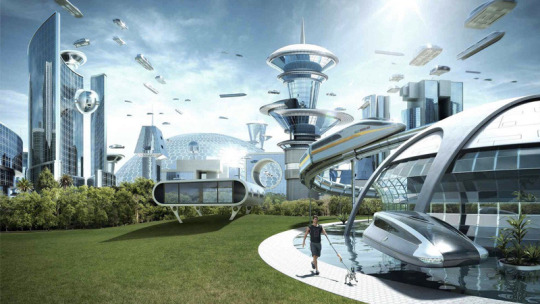
#sso#ssoblr#star stable#star stable tumblr#star stable online#I know event storylines in sso are not too big#but MAN at least there WAS a questline#the equestrian festival questline with Sabine was kinda meh but at least THERE WAS A QUESTLINE#(my favorite event questline are the ones with Linda were we uncover Galloper Thompson’s lore and memories)#i am begging on hands and knees that they at least do something with it#I’m kind of disappointed knowing that this camp is permanent and not just a unique event for the birthday#but if they make that camp permanent at least PLEASE offer it a questline#things to do#you know#not just a jousting race and clothes and then let the place rot for the next 10 years#I’m trying to stay positive and telling myself that it’s like that because it’s week 1 and they’ll add much more stuff later 🥲
91 notes
·
View notes
Text
Mark & Georgia’s 2018 Road Trip
Day 1: Graeagle to Big Bar, CA, 242 miles
Ready to roll. We packed our camper and truck very well. Minimalist as Mark is and as a minimalist wannabe I am, we did very well. For clothes and shoes, I, Georgia, continue to fail on my minimalist efforts – I just have to have 7 extra shirts, 3 extra shorts, and pants, and undies, and socks, etc,. Our packed supplies will keep us clean, warm, healthily nourished and hydrated (on both sides of the spectrum of health?) for at least 2 weeks. Packed all organized by activity, coffee and breakfast, anytime cooking, anytime dining, anytime bath, anytime grilling.

On the road! Big Bar wasn’t a real destination but a layover between home and the coastal redwoods parks – that’ll be tomorrow’s update. When we reserved the site at the Del Loma RV Park the gentleman on the phone warned us that if we needed gas or groceries get should them in Weaverville as there’s nothing in Big Bar. Good advice, he was absolutely correct. The drive here was uneventful, Mark kind of likes going slow (max speed with a trailer is 55 MPH but the roads we traveled were generally slower). Road construction slowed us down some, seems like everyone wants to finish their road project before winter sets in. Just west of Redding we entered the Carr fire area. Unbelievable devastation, you could see what used to be homes, what used to be autos, the town of Shasta was pretty much gone. To give you an idea of the size of the fire we drove through over 20 miles of burned forest before we reached the other side of the fire area. Very sad. Reached our RV park about 4 pm, not a bad place but kinda creepy (think Deliverance, banjo music, and all that…). Lots of people seem to live here at least semi-permanently, sort of a community with neighbors visiting each other and such. Funny thing is that everyone seems to retreat into their big RV’s around dinner time, to cook, eat, and watch TV (they all have satellite dishes). We’re trying to maintain some pretense of camping so we’re eating outdoors and enjoying our campfire and a glass of wine or two. Looking forward to day 2!

Day 2: Big Bar to Jedediah Smith Redwoods State Park, 146 miles
On the road promptly by 10:00 a.m., as planned. Today was an example of how you can drive 146 miles in over 6 hours, an average of about 24 MPH. We’d gone less than a mile from last night’s camp when we pulled over to soak in the view of the Trinity river canyon. We wound around with the river for about 60 miles, stopping frequently to take in the vistas, walk to the edge and peer over into the steep canyon, feeling vertigo. Thinking that there’d be many places we’d like to come back and fish. At the RV park this morning we saw (and followed, and asked questions of) a number of men coming back from the river with salmon. They were all complaining of the lack of fish and the small size, but the fish were all much bigger than the trout we catch, bigger than our biggest trout!
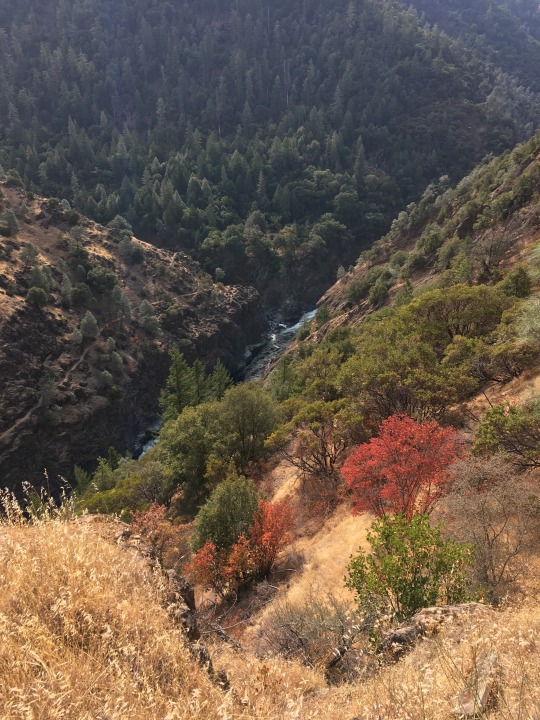
After arriving at the coast we drove north through Redwood National Park, Prairie Creek Redwoods State Park, Del Norte Coast Redwoods State Park, and finally to our campsite in Jedediah Smith Redwoods State Park. What magnificent trees! You can hardly appreciate their size, definitely too big to take a picture of them. Our campsite in Jedediah Smith CG is on the Smith River, among old-growth redwoods.
We tried fishing on the river, and saw fish – salmon? – jumping but we just aren’t equipped with the waders and other gear you’d need to go after them.
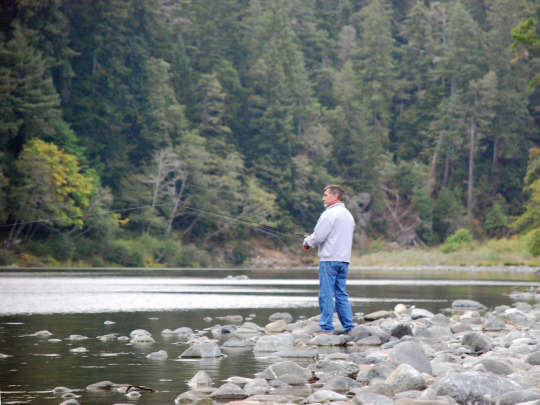
Anyway and back to the trees, to give you an idea of their size one in our campsite took me 23 paces to walk around. At around 2 ½ feet/pace, that’s over 55 feet in circumference! How old is that tree, how much history has it lived through? We, and the span of our lives are so tiny…
Driving through miles and miles of a forest of California redwoods is awesome and unique, knowing you will not see this anywhere else in the world. Ending the day at Jedediah Smith CG, to be camping and sleeping inside this canopy of majestic and towering redwoods, alongside a breathtaking river that “runs through it” is as amazing as it can be. All this, with the clean toilets and coin showers of JSCG, very nice, a “must see”!
Coming into Crescent city in the afternoon we wanted to find some fresh salmon and asked some locals in a gas station if they knew a good fish market – they “didn’t think there was anything like that around here….”, with the wharf right across the street from them. Georgia used Yelp to find a market out on the wharf, and we bought a nice piece of fresh King salmon for dinner. Yummy!
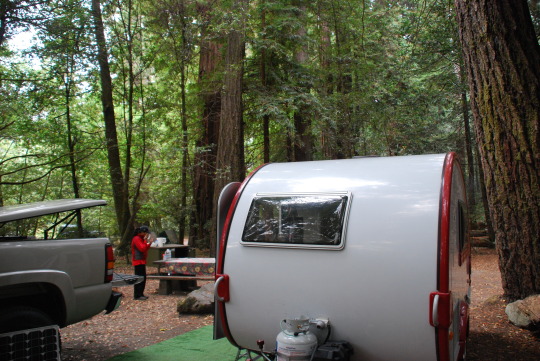
Day 3: Redwoods to Prospect, Oregon, 135 miles
Today’s drive was an easy “positioning” run to get us outside the south end of Crater Lake National Park, which we’ll visit tomorrow, ending the day in another camp just on the north side of the park. Leaving our campground we said goodbye to the California coastal area, and now followed the Smith River upstream in a northeasterly direction. We had fewer miles today and didn’t set another slowness record, but pretty close – we barely got out of our campground when we pulled over for a great view of the Smith River.
Into Oregon pretty quickly after that, still following the river for the next 50-60 miles. Once we turned onto Hwy 62 towards Crater Lake, we picked up the Rogue River which we’re still following and will continue to do so until we make the final turnoff into the park. After crossing one of the many bridges with a pretty view we pulled over and walked back to a nice park where people were fishing for steelhead – and quickly found wild blackberries which we snacked on until we couldn’t eat any more!
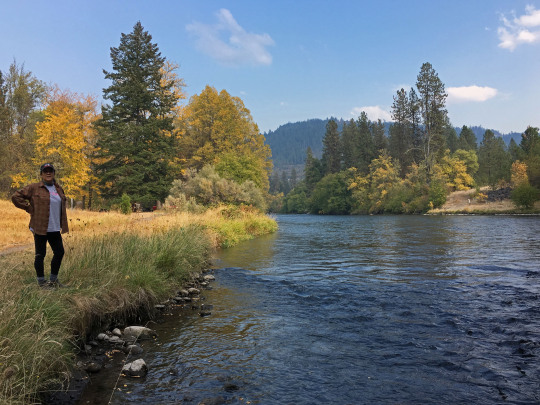
Late update: we’d heard a woman in a campsite across from us saying that it was going to rain tonight, didn’t pay much attention as the skies were blue and calm. While we were cooking dinner a ferocious wind came up and the skies were suddenly gray. I looked at the internet forecast and it said 30% chance of rain – shouldn’t be a problem. Well, we should go to Vegas because the 30% odds hit with a violent thunderstorm and strong rain, had us scrambling to get all the things we didn’t want to get wet back into the truck. Nice and dry, we had our first dinner inside our cozy camper!
Day 4: Prospect, OR to Diamond Lake, OR, 60 miles (+Crater Lake NP, about 35 more miles)
On the road by 9:30 am with most of the packing done and forced the night before by the onslaught of rain. Cozy and warm through the night, we thought in the morning that this little camper beats the h**l out of tent camping! We agreed that a simple breakfast of coffee, a piece of toast and a shared fruit would tide us over for a heavier lunch of a “sandwich”, very non-Asian for Georgia but fitting (or not so tight in the waist) for a day of driving and sitting ahead of us.
Our first stop was to fuel up at a station in Prospect which, not surprisingly, was the only one in town and only had one pump; at least they had diesel. We were told that “self-service” was not allowed in the state and so received personal fill-up service.
We arrived at Crater Lake National Park at about 11:00 a.m., and the entrance to the park was free courtesy of Mark’s senior card (definitely benefitting from this park friendly card as most of our entrance fees were either half off or FREE!). Crater Lake boasts of the bluest, the clearest and the deepest lake in the U.S. Although it was mostly a cloudy day, giving it a somewhat mystical feeling, it did not disappoint with being the bluest and the clearest.
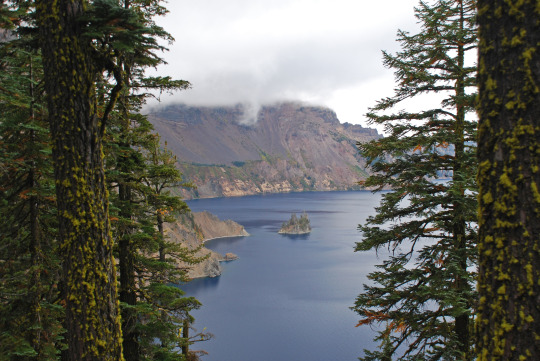
We didn’t test its depth claim as it is, at its peak of 8700’ elevation, also very supposed to be very cold!! We entered the lake from the south end, circled it 360 degrees via its rim, stopping at most of the vista points, then exited the park to the north. This took us over 3 hours to go about 30 miles, a new slowness record for this trip.

We proceeded to our next RV campground stop which is Diamond Lake, just a few miles north of Crater Lake. It’s interesting that RV camping at this time of the year leaves you camping with seniors that have all the time for RV’ing, and camping in these ‘rigs’ that dwarf our little T@B, much like a Bichon amongst an army of St. Bernards, but we are happy with our Bichon. The more St. Bernards, the less traffic in the restrooms and showers. These campgrounds also tend to have grandma and grandpa types running it so the toilets and showers tend to be very clean, some almost sterile, and cozy (a bench, a heater, lots of wall hooks, bright light and a private changing room).

Our campground is very close to a pizza house and we decided to go there for our Day 4 dinner of pizza and hot chicken wings with celery sticks, with our choice of a side dip of blue cheese. When the order arrived, the celery sticks were missing so after Georgia asked about it—they got handed over a minute later with apologies…. two 2-inch sticks delivered by hand… definitely one of the highlights of the day!! Enjoyed all of 2 short pieces of the celery sticks, the double pepperoni pizza was one of the best we’ve had plus the Buoy IPA on tap wasn’t bad!
Day 5: Diamond Lake to Goldendale, WA, 235 miles
A real cruisin’ day, I think I’m (Mark) getting used to this. The first day I was a little nervous driving with the trailer (remember, all of our camping trips before this were within 20 miles of our house), trying to keep it centered between the lines, watching my speed on the curves. Now I’ve realized that the little trailer just happily follows the truck along, just have to drive pretty normally, look back now and then to confirm it’s still there. It, and the truck are starting to look like real road warriors (dirty!) especially after the rains and wet/dirty roads that resulted yesterday morning. Bought some 409 today and will try to shine it up a bit.
Today we drove mostly north, from Crater Lake through the Umpqua National Forest. 60+ miles of pine trees, but unlike Graeagle they’re pretty short and scruffy – to Bend, where we stopped for a sandwich, fuel, and potty break. After Bend, the landscape changes dramatically into rolling hills of ranches and wheat fields, amber waves of grain. Ok, the grain had all been recently harvested, but the stubble was at least amber. And how’d that picture below get into this blog?

Georgia’s family’s viber hotline was busy early morning amidst the sad passing of the youngest boy of close family friends, the Conejeros. We are saddened by this news and reminded how life can be fleetingly short, that family and friends do remember your happy moments, that there is an end and that we should really make the most of each day.
As Georgia reflected and said her prayers today, grateful for this trip and the gift of life, the “Lord’s Prayer” hit home a little differently….”Give us this day our daily bread..” Wait, why “bread” specifically and why not; “Give us this day our daily rice..” Yes, Georgia is beginning to crave rice at Day 5 after daily doses of bread... (Georgia, remember the amber waves of grain thing? – MC)
Camping tonight just across the border in Washington, with the Columbia River as our backyard. That’s one wide river! Must have some huge fish in it…once again our Bichon looks happy at Day 5 flanked by St. Bernards.
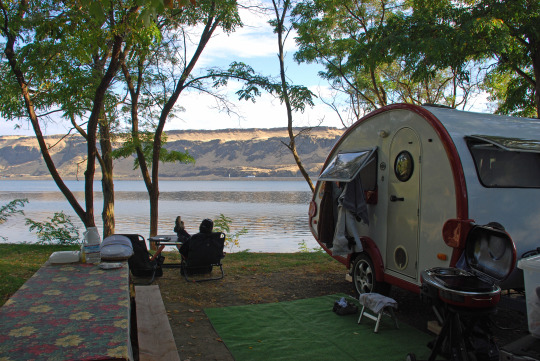
Day 6: Goldendale, WA to Coeur d’Alene, ID, 271 miles
Just as we left our camp on the Columbia River we noticed a round stone fortress looking thing up on the top of a hill. I thought it looked like Stonehenge and we definitely needed to go up and take a look. It turned out to be Stonehenge, or at least what the original non-ruin Stonehenge probably looked like. Correct in all the details, even with a chart of the sun and moon risings occurred during significant annual events. A plaque inside explained its existence, it was built from 1918-1929 by one of the town’s founders to honor local men who gave their lives in WWI. The things you find on the road.
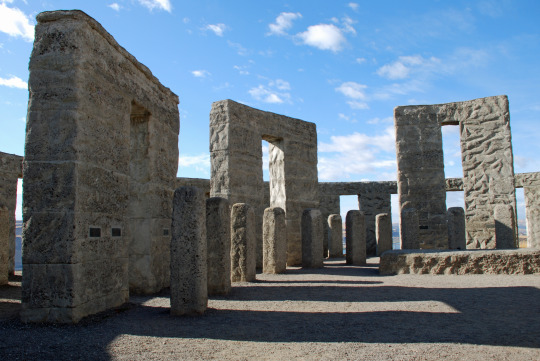
We made it to Idaho! Our longest driving day so far, driving through WA in a day, and I think this will be so until one of our last days when we blast across Nevada in one day. After Stonehenge we drove upstream (east) along the river, following the trail of Lewis and Clark for some 60 miles. What a sight this broad river must have been to them!
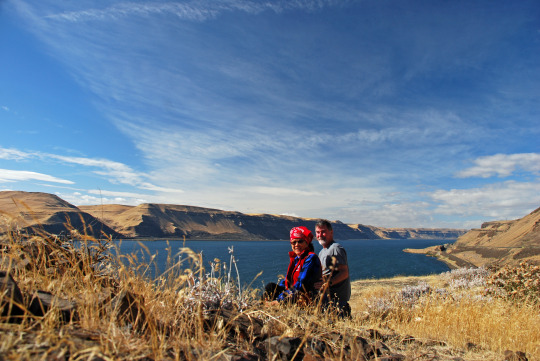
Our riverside highway dead-ended at US 395, and for the first time on this journey we joined an interstate which was to take us to Coeur d’Alene (we’re trying to stay on state and local highways, except where it’s not really practical). Getting out of the truck for a fuel and lunch break at Kinnewick, the wind almost ripped the door off the truck when I opened it – it was howling! Luckily the heavy truck and the light trailer are very stable, I hadn’t noticed the wind while driving. Re lunch, Perry’s comments about fried chicken stoked another craving in Georgia and we ended up at KFC…
After Kennewick we found that the combination of high winds and freshly worked field results in dust storms. We drove for the next 170 miles, through Spokane and all the way to Coeur d’Alene, in limited visibility from dust, sometimes a bad as a thick fog. About half way I had this flash that the front window in the trailer was cracked open (we do that so damp towels etc. will dry out while we’re driving). I pulled over at a rest stop, and sure enough everything inside was coated with dust. A good shake-out and wipe-down was required once we pulled in to camp. We’re in a great camp at the east end of beautiful Lake Coeur d’Alene, and the forecast was for the wind to abate by 9:00. It’s 9:02 at the moment so the forecasters are wrong as usual. We’ll give them until he morning. Camp Coeur d’Alene (Camp CDA) looks like another “must experience.” If we owned and ran a campground, Camp CDA will be a basis for its design (fishing, playground, kayaking (they provide kayaks and canoes for anytime use - free for all guests, not just for seniors!), choice of tents, cabins and glamping all in one big campground). Each site is designed to have a unique natural view, with community/group cooking and dining areas with big outdoor kitchens, multiple sinks and tables if you choose to use. One nice park perk---free firewood!
Day 7: Coeur d’Alene, ID
Happy to report that the wind and the dust were gone and we woke to a beautiful sunny day. Today was our first off day, to take a break from driving and enjoy the lovely town of Coeur d’Alene. We needed to go to the market to replenish our supplies; I was also planning to look into Tumblr to make this a real blog. We decided to go fishing instead. After breakfast we headed to a local fishing/hunting shop, bought Idaho 1-day licenses, and got filled with advice about where to go. Lake Coeur d’Alene is a noted fishing spot for trout, chinook and mackinaw salmon, pike, and smallmouth bass. But, it’s a large lake and to go after the big fish you pretty much need a boat. Another option was to try a smaller lake, Fernan Lake, which is located just on the edge of town, with public fishing piers.
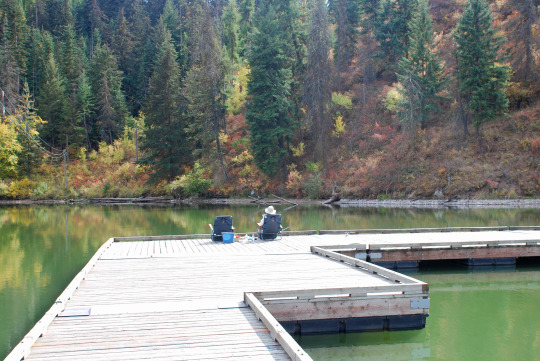
Pretty good trout fishing we were told. So we packed lunch and spent a pleasant afternoon on the dock, and yes we’re having Idaho trout for dinner. Not a ton of action but enough, 2 nice fat trout (the smaller one will be plenty for our dinner tonight), many nibbles, and a few that got away. Fishing appears to be a very popular sport here. In the 3 hours we were at the dock fishing, we saw a couple of local young folks with their fishing poles and bagged lunch and dressed in office clothes – long sleeved dress shirts, black slacks and black shoes… Made it to the store on the way home, of course we had to get a big Idaho potato to accompany the trout (we did miss the Walla Walla onions in WA!). And some rice. Good eats on the road!
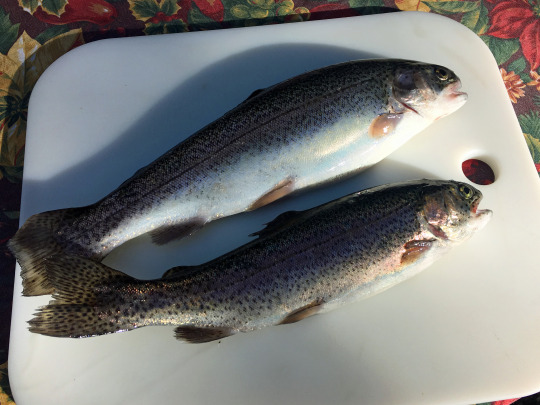
Day 8: Coeur d’Alene, ID, to Garrison, MT, 227 miles
Being that our next stop is “Bernie and Sharon’s Riverfront RV Park”, unusual for an RV park name, we were a little apprehensive. Leaving Lake Coeur d’Alene, we followed the river climbing the Rockies to the Continental Divide and into Montana. Beautiful forest, mostly pine, fir, and spruce, with now-golden aspen and poplars providing a striking highlight against the multiple shades of green. A pleasant drive through Montana, eventually linking up with the Little Blackfoot river and arriving in Garrison, about 20 miles west of Butte, and the home of Bernie and Sharon’s RV Park.
We met a most friendly Sharon, learned that Bernie had passed about 3 years ago, and learned a bit more about the campground’s history and the plan for its future. Also learned that there was some great fishing in the Little Blackfoot river that ran just behind the park. After settling in, we grabbed our poles and walked to the river, which I’d really call a creek rather than a river. Georgia started fishing while I was walking to another spot; I heard a whoop and saw Georgia with her pole bent over… she soon landed a nice 15” brown trout!
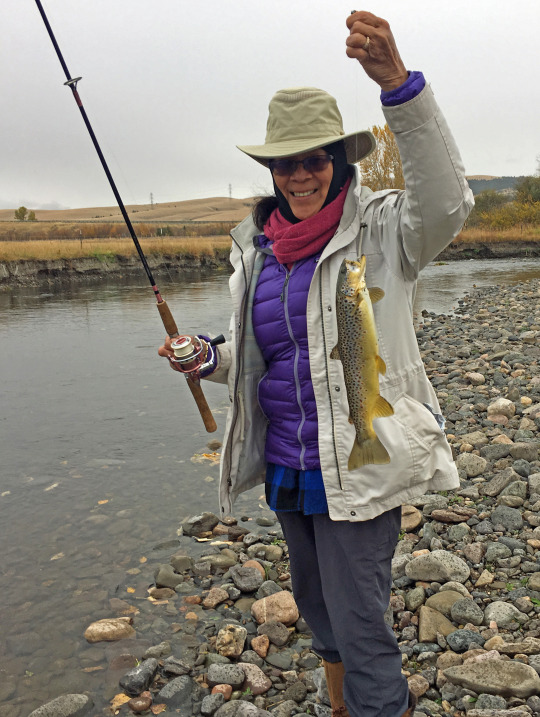
I fished for another ½ hour with no luck, and getting cold I was just about to call it a day when I got a bite and hauled in an even fatter 16” brown! Amazing that this little ‘river’ had some big fish in it!
This was our first very cold outdoor experience of this trip. The trout would have partied with Georgia’s crisp frozen fingers if they found these more delectable than worms or Powerbait! For this evening we used our camper heater for the first time to keep warm.
Day 9: Garrison to Columbus, MT, 246 miles
We had gotten some snow overnight, and the higher peaks around us had a dusting of white. The terrain stayed about the same, mountainous, forested, and with the accents of fall color from the aspens, poplars, and the occasional maple. Driving through Butte and then Bozeman we climbed up the snow-covered mountains; luckily the road was clear and dry. Finally descending we drove into central Montana, where the land became rolling hills, with a mix of cattle ranches and farms growing mostly wheat. It stayed much like this all the way to Columbus, where Mark’s nephew Chris has become a land baron, with over 60 acres where he has plans to build a house in the next year or so. Columbus is a small town in Stillwater County, MT, with about 2000 inhabitants. Chris’ property is not exactly in Columbus though, it was another 8 or so miles up gravel, dirt, and sometimes mud roads to his place. Chris had flown up to meet us there – he’s a captain with United Airlines so gets to fly anywhere, anytime – and welcomed us to his beautiful ranch.

Definitely off the grid up here, no electricity other than the solar panels we have for our trailers, no water other than what we bring, but at least there’s a cellular signal so you’re not totally cut off from the world. Lots of stars in the big sky, and no restrictions on the size of the campfire you build!
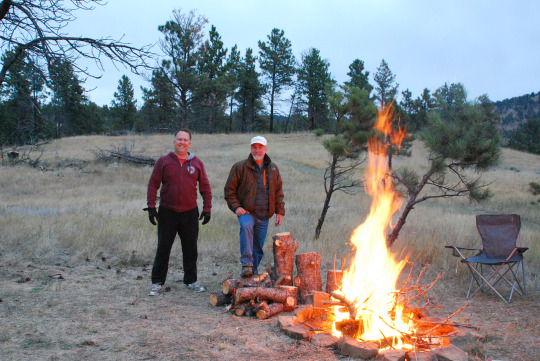
Dinner under the stars of chicken adobo, grilled chicken, and both Idaho and Montana trout were delicious. We agreed that the Idaho trout were a bit tastier.
Day 10: Columbus, MT
After a hearty breakfast of thick-cut bacon and one of Georgia’s excellent camp omelets with sausage and veggies (yes, we’re eating too much, too well), we headed out for the day. First a tour of Chris’ estate, and then the 30-acre frontage on the Yellowstone river owned by his homeowner’s association, then into Columbus for lunch. Didn’t we just finish breakfast? Never mind, at the 307 Bar and Grill and Casino (Columbus has about 2000 residents but at least 4 casinos…) we split a delicious French dip sandwich that could easily have fed 4 people. Georgia noticed that casinos are everywhere in the state of MT….
After a few errands we headed to the Stillwater river for some fishing. Neither Chris nor Mark had any luck but Georgia caught 1 ⅛ fish. You just can’t give her full credit for the first one, but the second was a decent-sized rainbow.
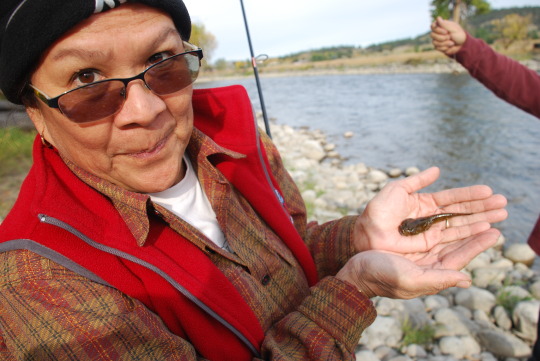
Back to the ranch for campfire and dinner we were all too full for a real dinner but managed to share a locally-raised steak (simply seasoned and perfectly cooked medium rare by Chris!) and some veggies. Tough life on the road…
Day 11: Columbus, MT, to Island Park, ID, 225 miles
Saying goodbye to Chris and setting off from the wilderness of Montana, we head towards out next destination, Yellowstone National Park. Since Columbus was the easternmost point on our route, we first backtrack about 60 miles to Livingston, MT where we pick up US Hwy 89 and head south, following the Yellowstone River all the way into the park. This is a great drive up through a picturesque river valley, with the fall colors vibrant all along the broad river.
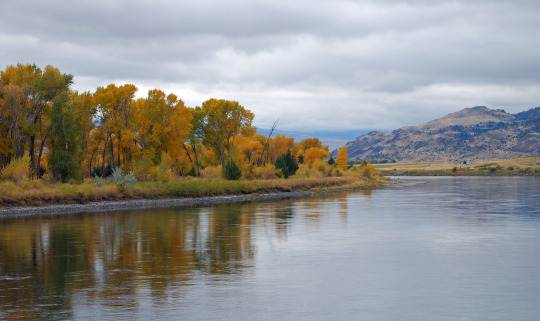
We entered Yellowstone at the north gate and quickly arrived at the Mammoth Hot Springs area. Georgia saw her first elk, as a herd of 25 or so cows and one lucky bull were grazing on the grass in front of the visitor center. Just like the deer at home who are surrounded by abundant food but prefer the green grass on the golf courses (and the shrubs in our yard…). We took a walk around the hot springs area, seeing the huge terraces built by the minerals in the hot water. At places, various bacteria that can thrive in the hot water turn the pools many different colors. One of the largest terraces, Jupiter Spring is no longer active – a sign explains that the thermal features in the park are constantly changing, and this particular spring stopped flowing in 1998. Mark remembers that in his first visits to Yellowstone, around 1970 and ’78, the spring being very impressive. I have to see if I can dig up some old pictures.
We drove slowly through the northwest corner of the park, not too far before we saw buffalo, another first for awestruck Georgia (Georgia has only seen these animals in movies or on slot machines – BUFFALOOOOO!, what a sight to see these awesome creatures up close!). We snuck around, feeling safe in a dense thicket of trees, avoiding stepping on their scattered mudpie shaped poops, to get some up-close pictures of the grazing animals. Driving on, we encountered our first “buffalo jam”, with three buffalo ambling slowly down the middle of the road, backing up traffic in both directions.
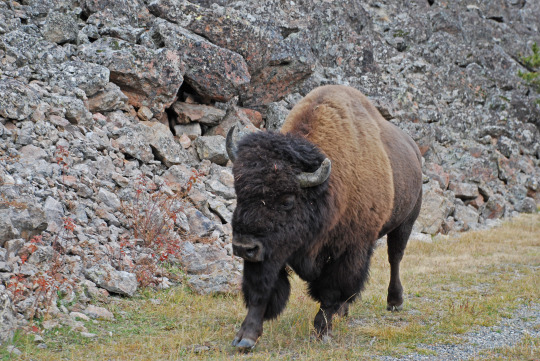
They seem to know that they have the right of way, and besides they’re way bigger than you are! Each time they veered from one side to another one or two cars could get by. When we got our chance to pass, a buffalo on Georgia’s side was close enough to the truck that she could have scratched it between the ears, but she declined to do so and just got some close-up photos (and a video to be shared soon). Georgia did personally invite these “bufffaaalloows!” to Las Vegas and to Reno for the “Buffalo Gold” rallies.
As it was getting late in the day we exited Yellowstone to the west, into the tourist-town of West Yellowstone and its overabundance of motels and souvenir shops. We kept going a short way to Island Park, Idaho, the location of our little cabin. Yes, we’re abandoning the trailer for a mid-trip break in a VRBO rental house. Real beds, showers, kitchen, and most important a washer and dryer! Nice cozy place, with a view of Henry’s Lake out the front. A perfect base for exploring Yellowstone.

The cabin provided an extremely comfy bed, clean linen, an immaculately clean toilet and shower, fresh towels, and the ability to wash, dry and fold all our dirty laundry. The smell of freshly dried clothes, the bathroom mirror and the after-shower mist made us realize that we not only smelled smokey and dirty—we also looked it.
In the next 2 days we will be visiting the Yellowstone National Park daily, entering it from its west entrance and then coming home to our cabin. Each time we enter and exit to come home, we transverse through 3 states, Idaho, Montana and Wyoming, all within 10 miles of driving—how is this possible in the US with all this land?
Day 12: Yellowstone NP
A beautiful day with blue skies and puffy white clouds… but a little chilly, it had warmed up to 33° by the time we left the cabin at 10:00. Back into the west entrance to the Madison junction where we turned south towards the Old Faithful area. Our first stop was along the Madison river to take in its beauty.

Moving on we quickly got into another buffalo jam. They do seem to like to use the roads to move around, they must think it’s the express lane compared to the fields.
Just before we got to the first thermal area we encountered a herd of elk in a meadow. The herd, comprised of around 25 of these huge animals was moving slowly along, seemingly led by the largest female. A single bull with an impressive set of antlers brought up the rear, probably making sure nobody else messed with his harem.
We parked and walked into the Upper Geyser Basin, where we viewed a number of colorful hot springs, and were treated to the eruption of nice little Clepsydra geyser.

As compared to the summer when it’s absolutely packed and crazy, it seemed that there were few people in the park, but at our next stop to see the Grand Prismatic Pool (a big, colorful boiling hot tub) the small parking lot was full and 10-12 cars were waiting for a spot. We drove on to Old Faithful instead.
The Old Faithful area is a big complex with a visitor’s center, restaurants, shops, and of course the elegant Old Faithful Lodge, the grand hotel of the park. Everything is centered around the geyser of course, and walking into the visitor’s center there’s a big digital sign telling everyone the only thing they want to know – when the next eruption is expected. We had about an hour to wait so we got a front-row seat and ate the lunch Georgia had packed for us. About 10 minutes before the expected time the geyser started teasing us with little burps of steam and water. The crowd was getting restless; one little boy near us must have asked his dad a hundred times “when’s it going to erupt?” Finally, right at the appointed time the geyser sprang into action and sent a column of water some 100’ high into the sky. Unfortunately, right at that time the breeze shifted and blew all the steam directly at us, so we saw mostly steam and not much geyser. Oh well, that’s Mother Nature for you. At least Georgia got to see Old Faithful, a must for every visitor to Yellowstone.

Day 13: Yellowstone NP
We awoke to a dusting of snow on the ground (snow was expected on and off all day), and drove back into the park. The snow, and the accompanying low temps, gave the park a new, wintry look and feel. Our first stop was to see the Grand Prismatic Pool which we had missed yesterday. Very few cars in the parking lot this time, and after a short hike we saw… mostly steam. Makes sense that the colder the air gets the more steam the hot water (up to 190°F!) generates. When the steam shifted you could get a glimpse of the turquoise water, surrounded by vibrant orange, yellow and brown deposits. The deposits, and even the blue tint of the pool, turn out to be due to different types of bacteria that thrive in the extreme conditions.

We pressed on past Old Faithful and up towards Grant Village. This took us along the shores of Yellowstone Lake, the largest high-altitude lake in the U.S. We had planned to stop at the village and have lunch in one of the restaurants but found it closed for the season, including all the restrooms! Never unprepared (food-wise) Georgia produced some hard-boiled eggs to tide us over until we could find a place for lunch. That turned out to be in Canyon Village, another 20 or so miles up the road. That trip was interrupted by what was to be a short stop to see a bubbling mud pot along the roadway. There was also a longer, steep trail going to a few more mud pots which we weren’t going to do, but then a young woman coming down the trail told us we really should go up as a herd of buffalo was warming up at one of the hot springs. So up we went and sure enough there was a very contented and apparently warm herd.

The trail was a loop, and as we rounded the pool where the buffalo were, there was one eating right next to the boardwalk. Not enough room to safely walk by, we waited and waited for him to move but he seemed quite content to graze just where he was. Finally getting cold we retreated the way we’d come.
Reaching Canyon Village, one of 3 eateries was open, and we found some pretty good chili and a chicken/broccoli/garlic noodle bowl. Nice to have some hot food on a chilly snowy day!
At Canyon Village we’d just passed the drive along the rim of the “Grand Canyon of Yellowstone” so we backtracked a few miles and took the drive, stopping at every overlook and walking every trail. It may seem a stretch to call it the “Grand Canyon” when you consider the real thing in Arizona, but even on this cloudy day the beauty we saw, in the colors, the dramatic geology, and the river below, it truly earned the name, and seeing it was a fitting end to our adventures in Yellowstone.
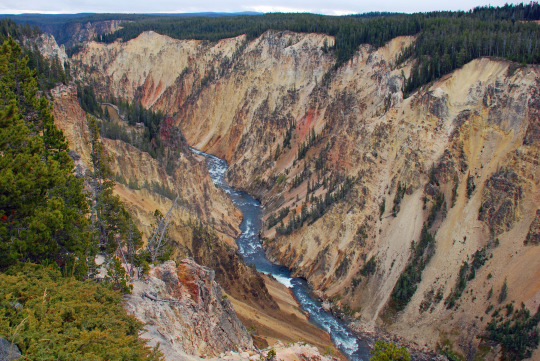
Day 14: Island Park, ID, to Jackson, WY, 85 miles
A tad sad to be leaving the homey comforts of our beautiful Idaho cabin by the lake, we packed up the trailer to get on the road again after our 3-day layover. Nice and brisk this morning, an inch or so of snow on the trailer and 27 degrees when we pulled out shortly before 10:00. A short cruise today over to Jackson, through the Targhee National Forest, lush green punctuated by stands of golden aspen. We made a rapid descent into Ashton, ID and were immediately into rolling farmlands of wheat, and of course, potatoes (saw several seed potato silos and some vodka distilleries along the way). Following small state highways, we passed through many nice towns, seemingly prosperous as judged by the modern amenities available in these towns of less than 2000 residents. Passing into Wyoming, we joined Hwy 22 over the Teton Pass. One of the scariest mountain drives ever (well, maybe not counting most anything in the Philippines…), a very curvy road with 10% grades both up and down. Very happy to have the power and control of the big truck pulling the little trailer!
The plan was to check into our RV park around noon, then head towards Grand Tetons National Park, which you enter only 4 miles north of Jackson. We took a quick stop at the town square in Jackson, with its famous elk antler arches (there are 4 of these, on each corner of the town square). They are something to see and to be photographed with. Plaques explain that all the antlers were collected in the late 1950’s by slave labor (Boy Scouts).
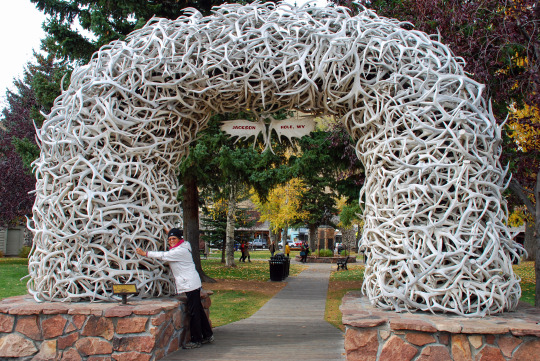
On to the Tetons. We’ve had this weather system the last couple days, with snow flurries and low clouds. The Tetons are very high mountains. Low clouds + high mountains = low clouds. So unfortunately we didn’t have a view of these impressive peaks, but the mists gave what we saw a mystical appearance. Amidst the sun peeking through the flurries of snow and the clouds, you see glimpses of all of Teton’s grandness and its steep canyons separating the peaks’ ridges. A few times, Mark said: “Trust me, the grandeur of those mountains are really there…just covered today.” A good animal day though, we saw deer and antelope (no, they weren’t playing together), elk, and the big catch – a momma moose with her baby (baboose?).

On the way out of the park we took a drive to a Mormon settlement from the 1890’s, that still has a number of original log homes and barns standing. The cold wind with nothing to block it made you think of the difficult life these pioneers had (notice Georgia’s winter wraps? There are 3 more layers underneath!).

Heading back into town we had to stop at the “Million Dollar Cowboy Bar” where Georgia saddled up for a round! Glad we have a not-so-difficult life!
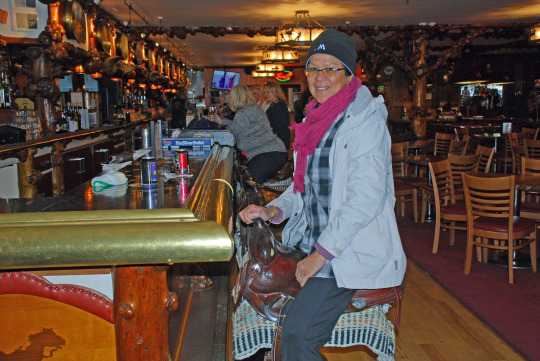
Day 15: Jackson, WY to Park City, UT, 250 miles
We started off with a nice drive down the gorgeous Snake River canyon, running through the Targhee National Forest, for about 60 miles. Beautiful country, especially this time of year with the fall colors against the evergreen forests, the river below, and the white peaks above. We travelled generally south, going through six states in one day! Wyoming, Idaho, Wyoming, Utah, Wyoming, and Utah. Does that count as six? Anyway it was hard to keep track of which state we were in.

Coming out of the forest around Afton, WY (home of the world’s largest elk antler arch!) the terrain transformed into the ‘high plains’ of mostly ranch land, bordered by high, recently snow-covered mountains. There are a lot of cows here, must be a cow for every person in the U.S.
We ended our travels for the day pulling into an RV park just a few miles away from Park City, UT. Taking little time to unhitch and set up the trailer, we drove back to Park City. How it’s changed! Mark was last here in 2006, and it was pretty much Main Street and a few adjacent streets.

Now the malls and condos start miles away, we had to pull over and use Google Maps to find the old Main Street. Thankfully that colorful area hasn’t changed a whole lot, maybe gone a little more high-end, but it’s still a nice walk along many shops, pubs, and restaurants. We took some time over a local brew to research the best place to have buffalo for dinner, that’s on the list for tomorrow, after a visit to Salt Lake City.
Day 16: Local Visits – Salt Lake City and the Great Salt Lake, 167 miles
On a quest to try bison…
Beyond bison, our plans for today were simple; to learn how Salt Lake City came to be (knew we had to have an understanding of the Church of Jesus Christ of the Latter Day Saints or the Mormon religion for this), to go to Salt Lake and either float on it and/or taste it’s brininess, and finally, to have a nice dinner in Park City and satisfy our curiosity about the taste of buffalo meat.
Our morning was unhurried (at least Georgia’s was…) and slept in a bit. Although we did use the furnace to keep the trailer cozy during the night, sunshine and blue skies greeted us by 7:30 am for a change. We left our camper at the CG and drove to Salt Lake City’s Temple Square which took us about ½ hour. Not having a detailed plan on how to tackle the Mormon immersion part of the day’s mission, we went into the first open entrance which was along North Street (next to the West St., of course) and went inside the North Entrance Visitor Center. Inside this was at least 3 floors of what we can only describe as America’s Vatican, with a modern twist. The different types of media they made available for the visitors were remarkably well thought out—paintings, sculptures, videos, narrations, private reflection areas, exploration of the Book of Mormon could be availed through areas with headsets, videos of their history, presentation of its founder Joseph Smith, testaments of missionary work, etc. We took 1 ½ hours reading, watching and listening.
We got hungry and ended up at Blue Lemon across the street from the Temple Square’s South Gate. We enjoyed our freshly prepared and well-seasoned veggie wraps and tacos. After lunch we went back into the Temple Square through, and admiring, the square’s middle manicured gardens and had a chance to compliment the 2 young ladies who were on active duty. We then proceeded to their tabernacle which was open, sat down and listened to the colossal pipe organ being played by this young man, the crescendos meant to vibrate the floor, your seat and your coronaries.
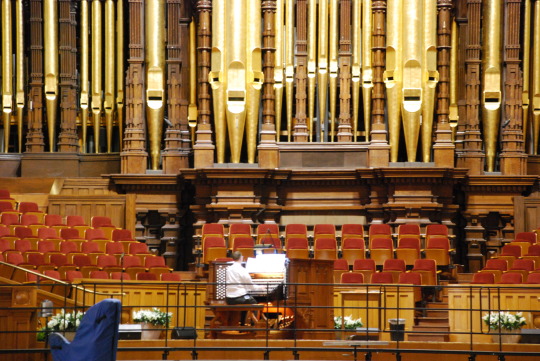
We then made our way to the South Entrance visitor center thinking this would be a smaller version of the North’s visitor Center. Naaah—this building showcased how Brigham Young led the “flock” to Salt Lake City and how the site for the Temple of our God came to be, how the temple was erected, the tools, the wagons, etc. Mark noted that one cannot enter the Temple unless you are a Mormon. Well, this building had a 10 foot replica of the outside structure as well as the inside structure, its rooms and furnishings. Next to it you get to see videos of the actual rooms—WOW! The furniture and design of the inside is meant to have the purest (think clean, white, gold), most beautiful adornments, best materials, best workmanship, it is after all built for “our God.”
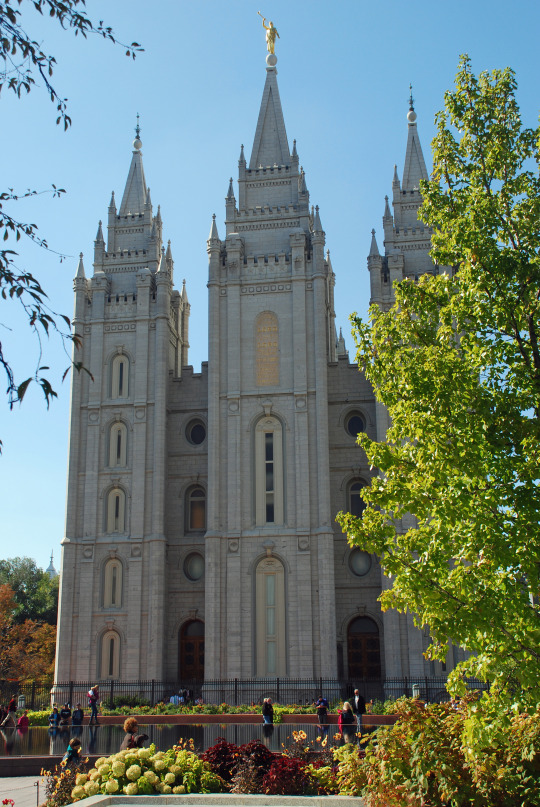
Mark and I agreed that taking the time to understand the Mormon religion a little, the foundation of their beliefs and their history were worth the time. A must do if in Salt Lake City!
Next was a drive to the Great Salt Lake at Utah’s Antelope Island State Park. The feel of the water – nothing different, the taste of the water – very salty after licking the dried salt crystals on your skin (note from Mark: been there, done that, didn’t feel the need to get crusty – only Georgia’s skin touched the water this time!), the smell in the air – a lot like a lot of dried shrimp, the walk to reach the water - looong! But still a must do if you have the time.
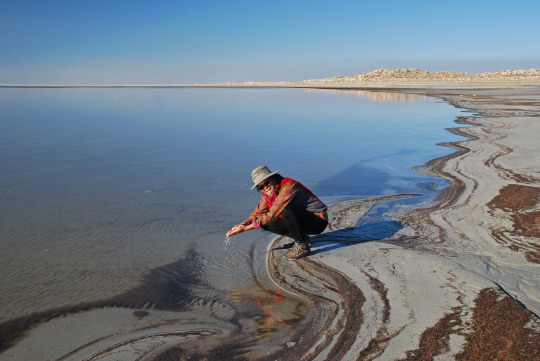
Buffalloooooo! We proceeded back to Park City for our dinner of buffalo, and since they didn’t have buffalo steak, Georgia opted for the only steak option in the menu, sirloin steak, while Mark went for the buffalo burger. The burger didn’t disappoint, had the tenderness of wagyu beef with less fat and the sirloin steak was as tender and flavorful as any steak we’ve ever had. We have to say the beef in Montana, Wyoming and Utah are certainly the best and that buffalo burger meat is indeed better than beef burger meat. After researching on beef quality and flavor, we are convinced that the secret to finding good flavorful beef anywhere in the US is finding the right store, one that specializes and takes pride in the fresh meat they sell.
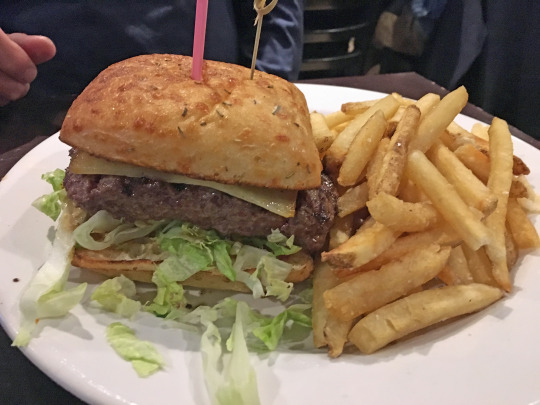
Day 17: Park City, UT to Baker, NV, 221 miles
This was a Blue Bird morning in the language of skiers, even though the ski season has yet to start. White peaks against that cloudless bluer-than-blue sky. We followed US 189 down through the Heber Valley, then through Utah’s Deer Creek State Park. We’ve seen this throughout this trip: snow-capped peaks with green flanks, orange and golden aspens, rivers and lakes. We’re fortunate to live in a place with similar beauty, but to see it over and over with different mountains and rivers and lakes is something we never tire of.
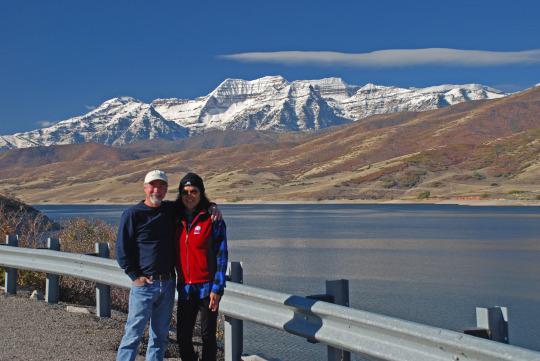
We descended a long grade into Provo, UT, a modern and clean looking place with that college-town look, being the home of Brigham Young University – lots of trendy places to eat, lots of outdoor recreation, flanked by the impressive Wasatch mountains. After Provo the country changed into rolling farm and ranch lands (more cattle) for some time – thinking of all that fresh beef we started looking for a local butcher, drove past the Ashton Farms Burger Barn and Meat Market in Delta, UT (burger of the month: double cheese burger with a crispy chicken breast!) – a quick U-turn and we bought a great looking rib-eye and some elk andouille brats that may make it home or may not…
Soon after Delta, we began our drive through the Great Basin. We already mentioned that the Great Salt Lake was a remnant of Lake Bonneville, a huge ‘ocean’ that covered much of western America. The Great Basin is the bed of this massive lake which is now mostly flat, arid country

We followed US 6 westward for some 60 miles, the road so straight it went on forever; when you reached forever it kept going straight as far as you could see.
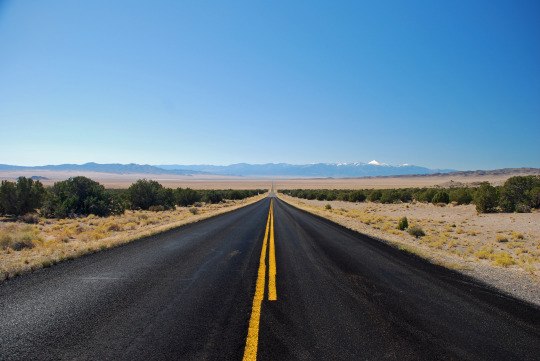
We crossed this first part in 60 minutes before we came to a range of interesting mountains – I had the thought that while interesting to me, what did the immigrants think, after days trudging thought this dry land, about these menacing hills? “Interesting” was probably not in their vocabulary. And then, after a steep climb and descent (with the road we traveled blasted through the rock to make it less steep and curvy) what did they see? Another 60 or so miles of the same flat, dry country ending in an even more imposing mountain range. Wow, the immigrants had hope, faith, and perseverance that we’ll never know. This country has a strange, arresting beauty. In some ways the straight flat road tells you to speed up and get across this as fast as you can; the beauty begs you to slow down and take it all in.
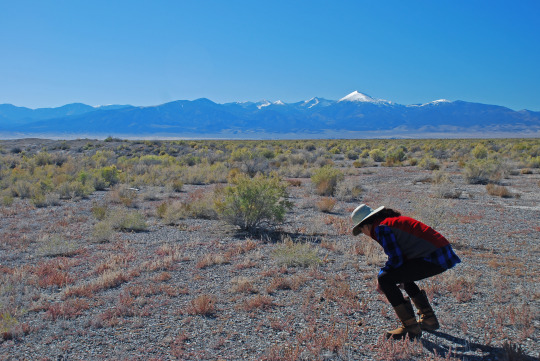
After a short prospecting stop – Georgia read about ‘rockhounds’ and wanted to see what it was all about, although neither of us would recognize a precious stone if it hit us in the head – we arrived in Baker, NV, population 68 (people, many more cows). The owner and hostess of the Whispering Elms Motel and RV Park is also the bartender in the saloon, apparently the hopping place in town. Why are we here? Baker was about a 4-hour drive (our standard day) from Park City and is the nearest town to the Great Basin National Park, on the schedule for tomorrow.
After about 10 days in very cold weather we appreciated the warm temps in Baker, put on our flip-flops and set up an outdoor table and chairs as we prefer to do. Poured a glass of wine, got dinner ready, started a fire, had some music going, all the stuff of a nice evening. After dinner as we were cleaning up, a strong, cold wind came up suddenly. Not strong, but STRONG! Got us hurrying to put everything away and get back into the cozy little trailer. Score one more point for trailer vs. tent (which would have been blown into the next county). For the first time Georgia thought our bichon could be flattened easily by that small tree if it fell on us.
Day 18: Baker NV, Great Basin National Park
Winter followed us from Park City to Baker, after last night’s warm start we woke to 20-degree temps and a strong wind that cut right through whatever you could wear. Our 2-gallon water jug was frozen solid!
Great Basin NP wouldn’t ever have been on my bucket list for National Parks to visit, but as it was about half way between Park City and Reno, it was a natural stop and one more NP to check off my list. Very undeveloped, only one paved road into the park, from Baker to Lehman cave. We took a 1-hour ranger-led tour into the caves, which were spectacular, even after many cave visits to more well-known caves such as Carlsbad and Mammoth, these were among the best and most well-preserved cave formations I’ve seen. And that’s after the early years of private exploitation, where the going rule was “if you can break it, you can take it”. Thankfully the formations must be pretty tough and there are a lot left for us to enjoy today, and more that are still forming for future generations.
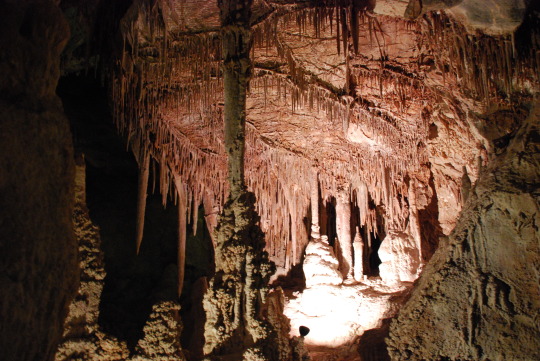
Great Basin NP is also about the Great Basin. Geologically, it’s recently the leftover lakebed from Lake Bonneville, which covered most of Nevada and much of Utah, Idaho, and Wyoming, as recently as 12,000 years ago. The Great Salt Lake is the last remnant of this drying lake, but we can see the tale of the ancient lake in its lakebed (now flat and arid valleys) and in the foothills and mountains, once islands in the lake. This has left us with great vistas, wide-open spaces.
We’re most thankful for our leaders who have made efforts to preserve these natural treasures we have, for us to enjoy and for all the generations to come. I’ll probably never make it to every National Park, but I know I’ll enjoy each one that I do see. More to come on the next road trip!
Day 19: Baker NV, to Reno, NV, 383 miles
This was our ‘blast across Nevada’ day, the longest day of driving in this trip. I’d really expected one long, mind-numbing drive across featureless desert. I guess my Nevada geography was off a bit. We started by rounding the northern edge of Great Basin NP, with a great view of 13,065’ Wheeler Peak and the other dramatic peaks in the park.
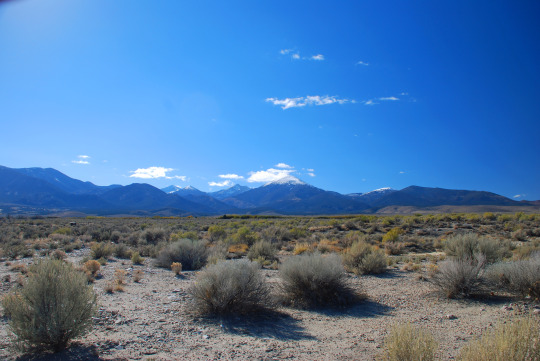
Up and over the Sacramento Pass and down into the valley below. Across the flat valley and up and over another range, down into another valley, and rinse and repeat... I finally remembered a lesson from a book I read last summer (Hard Road West by Keith Meldahl) which is a history book written by a geologist. It follows the trail of the immigrants to the California gold fields in the 1850’s and ties in how the geology of the land they were traveling over affected their journey, and how the land came to be the way it is. The part that came back to me today was about travel westward through the Great Basin. “Basin” is a hydrogeological term describing how water entering the area doesn’t get out (doesn’t flow to the sea) rather than describing a flat area like the bottom of a wash basin. Anyway, the part that affected the immigrants is that many millions of years ago the basin was indeed flat, and also the west coast was much further west than it is now. The Pacific plate of the earth’s crust moves eastward, sliding underneath the western US plate, pushing California eastward. This compressed the Great Basin causing it to “wrinkle”, forming north-south running ridges – the photo here is looking north into a flat valley between two parallel ranges to the east and west.
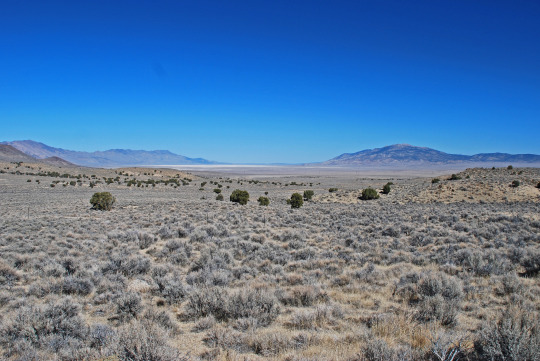
The significance of this lesson was lost until today as we repeatedly crossed a 10 or 20 or 40 mile-wide flat valley floor, then an imposing mountain range with a 7500+ foot high pass. Then another, then another, 8 or 9 in all, I lost count, all the way across Nevada, until you come to the baddest wrinkle of all, the Sierra Nevada.
Can you imagine what the immigrants felt when they finally fought their way over a pass, only to look west and see yet another valley and mountain range?
Much of the drive through the Nevada Great Basin was on US 50 – signs appropriately called it “the loneliest road in America”; miles and miles of long stretches of straight one lane roads, repeated after crossing another mountain range. Georgia theorizes that Reno grew to the big city that it is (in comparison to the much smaller and less developed towns we saw along the way) because some immigrants just couldn’t go through another mountain range crossing nor another big lonely valley to trudge through to reach California. It had a little something to do with silver mining noted MC. But, Georgia could not imagine women immigrants traveling this trail… 6 months of wagon camping from the Midwest seems unhealthy with so many environmental challenges to contend with—Reno perhaps was a compromise, as all good relationships require?
Bottom line is that crossing the middle of Nevada was much more interesting than we thought it would be. We’re very thankful we weren’t among those immigrants!
Arrived in Reno a little after 4pm (after 9am start), selling out to the comforts of a shower, clean bed, and a celebratory dinner at the Silver Legacy. That shower felt great (nice when you don’t have to worry about touching the walls or having to balance so your feet don’t touch the floor), and our Sushi dinner was a treat, not just because we haven’t eaten well on the road but it’s something we don’t have at home.
Day 20: Reno, NV to Graeagle, 61 miles
After sleeping in, another shower, and a big breakfast we hitched up the little trailer for the last time on this trip, and made the uneventful 1-hour drive home. The last time we drove home from Reno with the trailer was the day we bought it; I was nervous and checking my rear-view mirror every 2 seconds to make sure it was still there. I feel like a pro now!
A little sad to be ending our adventure, but it’s softened by coming home to beautiful Graeagle. A perfectly blue and warm October day, with the aspens in the front yard a brilliant yellow. Maybe the best way to get over the sadness will be to start planning our next road trip…

1 note
·
View note
Link
Let’s be honest. The past few years have spiked the “hopeless meter” in many of us socially conscious and concerned Americans. On a personal level, I can tell you that there have been more than a few moments when I’ve found myself feeling absolutely depleted and defeated; like all my efforts were futile; like the world was careening down the wrong path and I couldn’t do a darn thing to help it change course.
It’s been a tough few years, alright.
The good news is that every time I find myself dancing on the rim of what I call the “Black Hole of Hopelessness,” I’m reminded that shining above the darkness, there’s still so much light in the world. It may be days or weeks before I can refocus and recognize it clearly once again. It may take a friend or family member to show me the way. It may even require some serious personal time and difficult soul searching, but, ultimately, I know I will get there.
I know that wallowing in my Black Hole is not an option, because living down there means allowing my fears, negative emotions, and all that’s wrong with the world to win.
I can’t let that happen. We, as activists and humanitarians, can’t let that happen. So, how do we avoid the negative pull of the Black Hole of Hopelessness?
The Difference Between Acknowledging Your Hopelessness And Tumbling Into It
There is a big difference between acknowledging the Black Hole of Hopelessness and allowing yourself to be sucked into it. Accepting that the darkness looms is a healthy thing. It’s important to recognize that your feelings of hopelessness, despair, and doom are genuine emotions. Some might even argue they’re grounded in pretty convincing evidence that things aren’t going so splendidly these days.
Acknowledging these “dark” feelings is the only way to come to terms with them and eventually emerge on the other side. I can assure you that it will do you no good at all to put on a happy face and go through the motions of daily life, while underneath you’re suffering and seething. This merely perpetuates the problem and makes that Black Hole’s pull even stronger. If you want to overcome those negative emotions and get back to your hopeful self, you must first openly acknowledge they exist, they’re strong, and they’re impacting your life in the wrong way.
If you want to overcome those negative emotions and get back to your hopeful self, you must first openly acknowledge they exist, they’re strong, and they’re impacting your life in the wrong way.
Failing to do so may send you headfirst into that Black Hole of Hopelessness, and, once you’re down there, it can be a hard climb out. It becomes easier to expect the worst. You become willing to accept that things will never change and that fighting for ideals that matter to you is pointless. After all, why risk being disappointed when it’s so much safer to manage your expectations by eliminating hope altogether?
Before you know it, that Black Hole will start feeling a little too cozy and climbing out will take one monumental effort. So don’t get sucked down! Acknowledge your emotions and give them their just due so you can work through them and emerge recharged, refocused, and ready to get involved.
This Too Shall Pass
Somewhere between gloom and doom and eternal optimism lives a gray area where we can make real change. In this highly aware state, we acknowledge the current climate as challenging, but also rejoice in the truth that the situation is not permanent. That it can and will change; that we can play a role in directing that change; and that our voices will be heard if we’re willing to speak out.
Living in this gray area, we’re able to see the big picture. Rather than existing in an abject state of hopelessness and outrage, we choose to acknowledge that some things are, indeed, outrageous and infuriating, but that these things can be changed. We grasp that the histories of our nation and the world have been fraught with difficult times, but no matter how horrendous or horrific, the darkness eventually abated.
In other words, we come to believe the old adage, “this too shall pass.”
Granted, seeing the light can be hard in today’s politically charged times. Our nation is as divided as we’ve ever witnessed it. Families are being disrupted. Friendships are being ended. Our American values are being questioned at home and abroad. Allow yourself to feel sad, angry, and confused about all of this without being sucked into that Black Hole of Hopelessness. Remember that our actions matter. Remember we are engines of change. Remember that small gestures can make large dents in the fabric of the universe.
You may be tired, and feel hopeless, but don’t be scared. Acknowledge the hopelessness and darkness you feel, refrain from wearing a mask of happiness, remember that nothing is permanent and that clinging to anything—whether it be hopelessness and despair or our plans to change the world—confines us to suffering. This too shall pass.
How to Navigate Your Way Around a Black Hole of Hopelessness
1) Connect with others who are passionate about the same issues. Whether it’s your self-care buddies, community of care, or a local organization or campaign you are volunteering for, surround yourself with people who can understand how you feel. Venting alone doesn’t help – trust me, I’ve tried. But combine complaining with action? There is a winning recipe! My girlfriend Miro and I lean on each other often – we text, talk and meet up to vent – but we always seem to walk away with action items of how to constructively do something about the things we want to see changed. Having a friend like Miro validates how I feel and reminds me that there are others out there who feel the same way.
2) Put good deeds back into the universe—directly. This one is different than finding the issues you are passionate about, politically-speaking. It really focuses on creating that human connection, on giving back and showing others that there is still kindness in the world. For years, I’ve been very involved with a community of need, helping to organize clothing and school supply drives, fundraisers and summer camps. Each year, we organize a shoe drive and initially, I would just drop the shoes off at a collection site. But then I began delivering shoes directly to these kids. I was able to see their faces as they picked out their new shoes. I helped them try them on and tie their shoelaces. I connected with them on a human and meaningful level. It’s still one of my favorite times of the year. My advice is to balance your self-care with a healthy dose of kindness activism.
3) Curate your methods of staying informed. Truly evaluate how much news you are absorbing and be mindful of how the news affects you – physically, mentally and emotionally. Almost two years ago, I decided to stop getting my news from television. I found the visuals being shown and the repetitive nature of the stories on the cable news channels deeply disturbing. So, I vowed to get all my news through reputable print sources and by reading the transcripts of important interviews or speeches. I also turned off all but one of the push notifications on my phone in order to limit interruptions during the day.
REMEMBER, IT’S HUMAN TO FEEL HOPELESS.
You might as well resign yourself to it. Some days are going to feel a little darker than others. The key is making sure those times of despair and frustration don’t snowball and send you over the rim and into the Black Hole of Hopelessness. We cannot allow ourselves to fall victims to despair, anger, and negativity. Feeling these emotions and acknowledging them is great. Giving into them is dangerous.
This is one of the main reasons it’s important to have self-care buddies and communities of care to lean on in tough times—We can reach out and feel that there are others sitting in the space with us; we can hear their kind words, and we can experience our hearts connecting. We can take comfort in knowing that so many important issues are now part of the national conversation because caring people refused to feel or act as though they were hopeless. We can look to history to remind ourselves that despite dark times in this world good ultimately prevails.
So let’s pledge to each other to avoid that Dark Hole. And let’s pledge to each other that if we see our community members in the Dark Hole, we will throw down a rope and help them back up again. Let’s call upon each other to balance the sitting down of meditation with the rising up of kindness, to ourselves and our communities.
SIGN UP TO JOIN SHELLY FOR A LIVE GUIDED MEDITATION AND Q&A THIS FRIDAY
read more
Well-Being
The Five Rules for Self-Care in Politically Charged Times
Being whole and meeting our own emotional and physical needs first, is the only way we will build the world we want to see in the future. Read More
Shelly Tygielski
January 9, 2019
Well-Being
Why You Need a Self-Care Plan
Three reasons to map out your self-care needs and how to create your own unique plan. Plus, how to get yourself back on track when you falter. Read More
Shelly Tygielski
February 20, 2019
The post Self-Care for Dark Times appeared first on Mindful.
0 notes
Text
Why I Despise AoT’s Main Characters
At time of writing, the long-awaited second season of Attack on Titan, or as it’s called by some of its fans Shingeki no Kyojin is close on the horizon. The stunning and all too brief trailer left me nostalgic for when I first watched the series in 2013 from under my blanket at 11pm, blinking away a haze of Monster energy drink and tears. This nostalgia led me to rewatch the anime’s first season and official spin-offs created by the same studio. My elation at reliving the thrill of the series, however, was stunted by my sudden realization that I couldn’t stand any the leading characters.
Now allow me to elaborate, I obviously don’t dislike the show as a whole. The aesthetics of the show are consistent and interesting, from the environments to the military uniforms consisting of an unbuttoned crop top jacket, a copious amount of belts, and a miniskirt. Attack on Titan is effective in conveying just how threatening the Titans are by the manner in which they move, look, and sound. While a little in-your-face at times, the symbolism is quite enjoyable as well. The last and most important hurdle, of course, is characterization, and oh boy does Attack on Titan fall short on this one.
Before I tear into this show’s writing with the self-righteous vigor of a fat World-of-Warcraft player tearing into his bag of Cheetos, I must state the difference between personality traits and qualities with regards to character. For those of you who failed 7th grade Language Arts, ability, ailment, appearance, alignment, and affinity (what the character likes or dislikes), etc. are all qualities, whereas things like kindness, courage, impulsivity, and discretion, etc. are personality traits. For example, The main character’s adoptive sister Mikasa has interesting qualities, but they are diminished by her utterly boring personality. Mikasa will repeatedly exhibit how she is effortlessly and inexplicably much more physically capable than anyone else, and that could get someone interested in her character, but once you dive beneath the surface, you find that the only only unique personality traits she displays are apathy and introversion. The main characters and many side characters in the series have the same problem, and never evolve past being archetypes. It is entertaining to see their conflicts and interactions in the same way it is entertaining to watch the emotions from Inside Out interact, but you wouldn’t actually want to talk to them in person because they are so predictable. This is why so many cringeworthy “Ask <character’s name here>” pages have popped up, every action that the characters take is predictable to the point where even internet fangirls are able to create dialogue that feels convincingly like it is coming from the actual character. However, the be-all-end-all judge of character is the question, “Do you want the show spend more time on them?”, and the answer with all three of Attack on Titan’s lead characters is no, not really.
And in answer to my question, the creators of the series decided to make a side story centered around Levi, the Lance Corporal of the Survey Corps, an elite branch of the military tasked with reconnaissance, intel-gathering, and R&D to some extent. I didn’t feel that Levi was in dire need of a backstory reveal, considering that it was obvious from the outset that he was a jaded war-veteran with a dark past and OCD. Now in that description the only personality trait I listed was “jaded”, and a jaded character isn’t interesting. Whenever he looks over a threat with a nonplussed, bored expression, I think to myself, “If he doesn’t view the threat as viable, then why should I?”, and I ponder if my time would be better spent impressing women or pumping iron, or whatever you non-weeaboos do all day. But I’m getting off track here. If you are seriously interested in a man who constantly stares at people with a mix of disappointment and anger, then you clearly don’t have an Asian Father. The writers working Attack on Titan then totally blew me out of the water when they released a spin-off that revealed, to everyone’s surprise, that he was in fact a jaded war-veteran with a dark past and OCD after all. The spin-off did end up showing off some very interesting characters, namely Isabel and Farlan, Levi’s friends. Now naturally, this being a prequel, the fate of these two characters was predetermined because neither of them are seen or even mentioned in the main plot. With the loss of these 2 characters, the show lost it’s ability to shock me, because it seems like the writers don’t know of any way to have characters be separated from each other painfully and permanently in any way other than death by Titan. An example of this would have been if Farlan was thrown in jail when people found out their plan to assassinate Erwin Smith, a captain in the Survey Corps, but Levi and Isabel weren’t found out. This could fit into the main storyline, and carry potential for future plots like if Levi had to do some high-ranking policeman’s dirty work to get Farlan out of jail. Honestly, I would take either character over Mikasa any day, but enough with ineffectual death, onto the main point, Character. Farlan, while kind and caring towards the unfortunate street urchins he lives amongst, still bears the demeanor of a thug. Isabel is loyal, eager to impress, humorous, playful, genuine, outspoken, and rude, despite her peppy, girly nature, she is not above assassinating a captain of the Survey Corps to be able to rise up out of the life of a dirt poor city dweller. Every character had a motive that made sense, with every character you could point at them and go, “I don’t exactly agree with your choices, but I see where you’re coming from.”. The writers did an excellent job of making the audience bond with characters who were only given about half an hour of total screen time.
The manner in which the lead characters’ comrades are characterized is lazy as well. Connie Springer, a recruit who attends boot camp with the main characters is referred to as stupid, and refers to himself as stupid, but never actually does anything to demonstrate this. In fact, the way he acts in combat and when trying to get sensitive information from a shell-shocked comrade, is quite quick witted and astute.
Footnote: Thanks for reading, I know this is kinda weird for a first post, but it would be awesome to get some feedback from you!
#aot#attack on titan#shingeki no kyojin#mikasa ackerman#review#levi rivaille#isabel magnolia#farlan church
1 note
·
View note